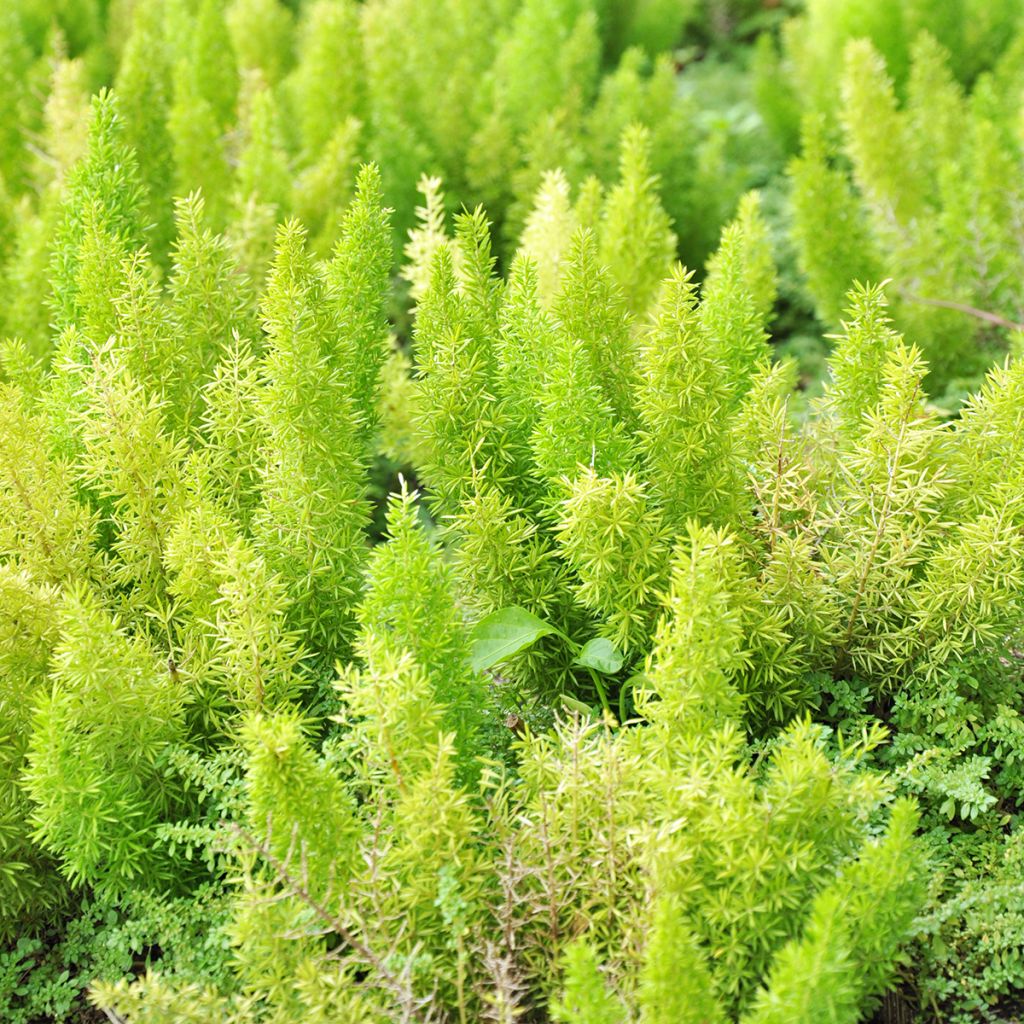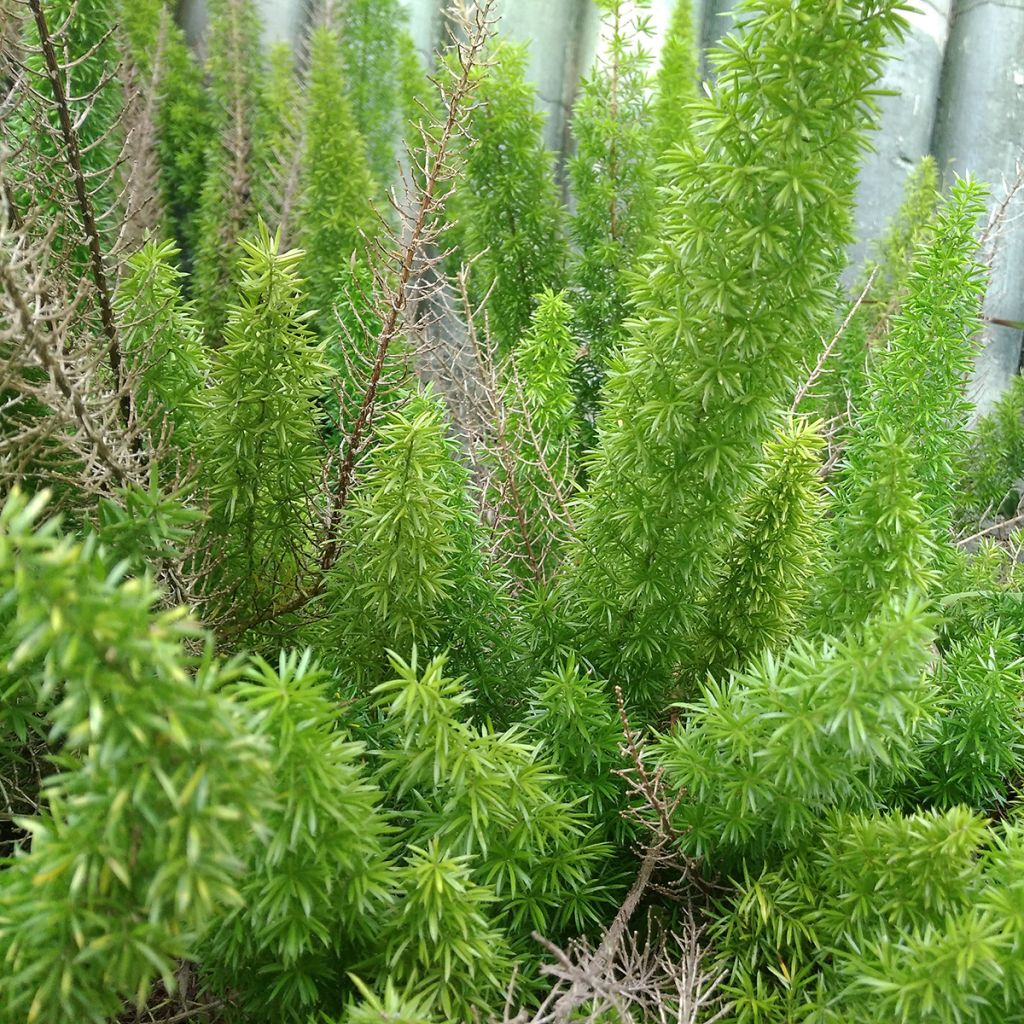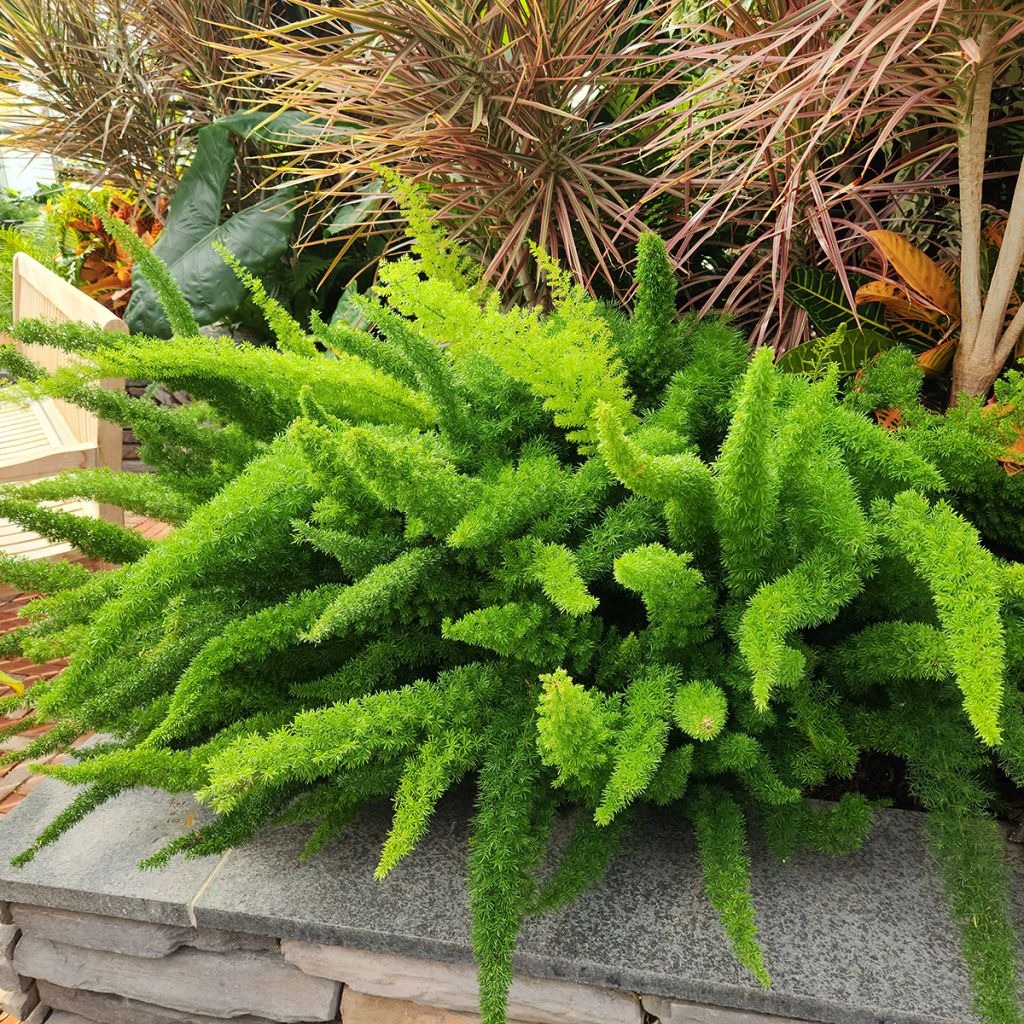Shipping country and language
Your country of residence may be:
Your country of residence is:
For a better user experience on our website, you can select:
Your shipping country:
Andorra
Austria
Belgium
Bulgaria
Canada
Chile
Croatia
Cyprus
Czechia
Denmark
Estonia
Finland
France
Germany
Greece
Hungary
Iceland
Ireland
Italy
Latvia
Lithuania
Luxembourg
Malta
Monaco
Netherlands
Poland
Portugal
Romania
Slovakia
Slovenia
Spain
Sweden
Switzerland
United Kingdom
We only deliver seed and bulb products to your country. If you add other products to your basket, they cannot be shipped.
Language:
French
German
Spanish
English
My Account
Hello
My wish lists
Plantfit
Log in / Register
Existing customer?
New customer?
Create an account to track your orders, access our customer service and, if you wish, make the most of our upcoming offers.


Asparagus densiflorus meyeri - Asparagus queues de chats


Asparagus densiflorus meyeri - Asparagus queues de chats


Asparagus densiflorus meyeri - Asparagus queues de chats
Asparagus densiflorus var. meyeri
Asparagus densiflorus var. meyeri
Foxtail Fern, Meyer's Asparagus, Plume Asparagus
Order in the next for dispatch today!
Dispatch by letter from €3.90.
Delivery charge from €5.90 Oversize package delivery charge from €6.90.
Current delivery delay: 1 day.
More information
This item is not available in your country.
Schedule delivery date,
and select date in basket
This plant carries a 12 months recovery warranty
More information
We guarantee the quality of our plants for a full growing cycle, and will replace at our expense any plant that fails to recover under normal climatic and planting conditions.
From €5.90 for pickup delivery and €6.90 for home delivery
Express home delivery from €8.90.
Does this plant fit my garden?
Set up your Plantfit profile →
Description
Asparagus densiflorus meyeri is an ornamental plant from the asparagus family, but often mistaken for a fern because of its appearance. It develops evergreen foliage of a very fresh apple-green colour, darkening slightly when ripe, organised in bushy clusters and composed of feathery cone-shaped leaves. These leaves are what gives it its other name of Foxtail Fern, just as its airy appearance evokes a fern. It is related to asparagus, although it is not edible. Not very hardy, it can be grown as an outdoor plant in frost-free areas, or as an indoor plant.
Asparagus densiflorus meyeri belongs to the Asparagaceae family. Originally growing in coastal dunes, rocky outcrops, or wooded areas, it is found from the southeastern Cape in South Africa to southern Mozambique. In the garden, the plant forms a tuft 40 to 50 cm (16 to 20 in) tall and spreads in the same way. It grows in USDA zones 9b and 10. Frost causes the above-ground parts to wither, but the stump can withstand temperatures down to -4 °C (24.8 °F). This plant grows in dense cylindrical or conical clusters. The long lance-shaped leaves stand upright and twist, giving this plant great ornamental value. The velvety and soft foliage forms a kind of open bouquet. The plant reproduces by seeds. In spring or summer, it can bloom in small clusters of insignificant white flowers before red berries appear on tiny stems. With vigorous growth in warm and tropical climates, where its tuberous roots grow rapidly, this "asparagus" remains much more modest in size when grown in pots in our climate.
Plant it in a frost-free area or in a pot to bring it indoors during winter. In the ground, give it morning sun and shade for the rest of the day in a humus-rich, well-draining, constantly moist to wet soil. As an indoor plant, grow it without direct sunlight, but with bright light, at temperatures between 18 and 24 °C (64.4 and 75.2 °F). Its soft green feathery foliage is beautifully complemented by light annuals such as cosmos or love-in-a-mist. In a hanging basket, its slightly trailing, light habit is attractive all year round. Surround it with a Staghorn Fern or a Medinilla magnifica, another beautiful indoor plant with an exotic look.
Flowering
Foliage
Plant habit
Botanical data
Asparagus
densiflorus var. meyeri
Asparagaceae
Foxtail Fern, Meyer's Asparagus, Plume Asparagus
Asparagus densiflorus 'Myersii'
South Africa
Planting and care
Plant the young Asparagus densiflorus meyeri in frost-free conditions or in a pot to bring it indoors for the winter. In the ground, give it morning sun and shade for the rest of the day, and grow it in a humus-rich, well-drained, consistently moist to wet soil. As an indoor plant, grow it without direct sunlight, but with bright light, at temperatures between 18 and 24 °C (64.4 and 75.2 °F). In a pot, plant it in a substrate that is rich in organic matter and lightened with draining substances such as perlite or vermiculite. Make sure it does not dry out too much between waterings.
Planting period
Intended location
Care
This item has not been reviewed yet - be the first to leave a review about it.
Haven't found what you were looking for?
Hardiness is the lowest winter temperature a plant can endure without suffering serious damage or even dying. However, hardiness is affected by location (a sheltered area, such as a patio), protection (winter cover) and soil type (hardiness is improved by well-drained soil).

Photo Sharing Terms & Conditions
In order to encourage gardeners to interact and share their experiences, Promesse de fleurs offers various media enabling content to be uploaded onto its Site - in particular via the ‘Photo sharing’ module.
The User agrees to refrain from:
- Posting any content that is illegal, prejudicial, insulting, racist, inciteful to hatred, revisionist, contrary to public decency, that infringes on privacy or on the privacy rights of third parties, in particular the publicity rights of persons and goods, intellectual property rights, or the right to privacy.
- Submitting content on behalf of a third party;
- Impersonate the identity of a third party and/or publish any personal information about a third party;
In general, the User undertakes to refrain from any unethical behaviour.
All Content (in particular text, comments, files, images, photos, videos, creative works, etc.), which may be subject to property or intellectual property rights, image or other private rights, shall remain the property of the User, subject to the limited rights granted by the terms of the licence granted by Promesse de fleurs as stated below. Users are at liberty to publish or not to publish such Content on the Site, notably via the ‘Photo Sharing’ facility, and accept that this Content shall be made public and freely accessible, notably on the Internet.
Users further acknowledge, undertake to have ,and guarantee that they hold all necessary rights and permissions to publish such material on the Site, in particular with regard to the legislation in force pertaining to any privacy, property, intellectual property, image, or contractual rights, or rights of any other nature. By publishing such Content on the Site, Users acknowledge accepting full liability as publishers of the Content within the meaning of the law, and grant Promesse de fleurs, free of charge, an inclusive, worldwide licence for the said Content for the entire duration of its publication, including all reproduction, representation, up/downloading, displaying, performing, transmission, and storage rights.
Users also grant permission for their name to be linked to the Content and accept that this link may not always be made available.
By engaging in posting material, Users consent to their Content becoming automatically accessible on the Internet, in particular on other sites and/or blogs and/or web pages of the Promesse de fleurs site, including in particular social pages and the Promesse de fleurs catalogue.
Users may secure the removal of entrusted content free of charge by issuing a simple request via our contact form.
The flowering period indicated on our website applies to countries and regions located in USDA zone 8 (France, the United Kingdom, Ireland, the Netherlands, etc.)
It will vary according to where you live:
- In zones 9 to 10 (Italy, Spain, Greece, etc.), flowering will occur about 2 to 4 weeks earlier.
- In zones 6 to 7 (Germany, Poland, Slovenia, and lower mountainous regions), flowering will be delayed by 2 to 3 weeks.
- In zone 5 (Central Europe, Scandinavia), blooming will be delayed by 3 to 5 weeks.
In temperate climates, pruning of spring-flowering shrubs (forsythia, spireas, etc.) should be done just after flowering.
Pruning of summer-flowering shrubs (Indian Lilac, Perovskia, etc.) can be done in winter or spring.
In cold regions as well as with frost-sensitive plants, avoid pruning too early when severe frosts may still occur.
The planting period indicated on our website applies to countries and regions located in USDA zone 8 (France, United Kingdom, Ireland, Netherlands).
It will vary according to where you live:
- In Mediterranean zones (Marseille, Madrid, Milan, etc.), autumn and winter are the best planting periods.
- In continental zones (Strasbourg, Munich, Vienna, etc.), delay planting by 2 to 3 weeks in spring and bring it forward by 2 to 4 weeks in autumn.
- In mountainous regions (the Alps, Pyrenees, Carpathians, etc.), it is best to plant in late spring (May-June) or late summer (August-September).
The harvesting period indicated on our website applies to countries and regions in USDA zone 8 (France, England, Ireland, the Netherlands).
In colder areas (Scandinavia, Poland, Austria...) fruit and vegetable harvests are likely to be delayed by 3-4 weeks.
In warmer areas (Italy, Spain, Greece, etc.), harvesting will probably take place earlier, depending on weather conditions.
The sowing periods indicated on our website apply to countries and regions within USDA Zone 8 (France, UK, Ireland, Netherlands).
In colder areas (Scandinavia, Poland, Austria...), delay any outdoor sowing by 3-4 weeks, or sow under glass.
In warmer climes (Italy, Spain, Greece, etc.), bring outdoor sowing forward by a few weeks.

